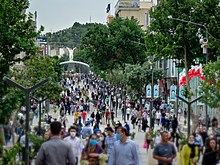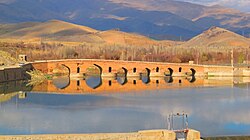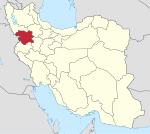Sanandaj
Sanandaj
Kurdish:سنە Sine | |
|---|---|
City | |
| Persian:سنندج | |
Sanandaj from Abidar, Sanandaj Museum, Khosro Abad Mansion, Qeshlaq Bridge | |
| Coordinates:35°18′41″N46°59′46″E/ 35.31139°N 46.99611°E[1] | |
| Country | Iran |
| Province | Kurdistan |
| County | Sanandaj |
| District | Central |
| Government | |
| • Mayor | Seyed Anwar Rashidi[2] |
| Area | |
| • Total | 3,033 km2(1,171 sq mi) |
| Elevation | 1,538 m (5,046 ft) |
| Population (2016)[3] | |
| • Total | 412,767 |
| • Density | 140/km2(350/sq mi) |
| Time zone | UTC+3:30(IRST) |
| Area code | 087 |
| Climate | Csa |
| Website | e-sanandaj |
Sanandaj(Persian:سنندج;pronounced[sænænˈdædʒ])[a]is a city in theCentral DistrictofSanandaj County,in theKurdistan provinceofIran,serving as capital of the province, the county, and the district.[5]With a population of 414,069,[6]Sanandaj is the 23rd largest city in Iran and the second largestKurdishcity.[citation needed]
History
Sanandaj's founding is fairly recent, (about 250 years ago), yet in its short existence it has grown to become one of the centers ofKurdish culture.[7][8]During theIran–Iraq Warthe city was attacked by Iraqi planes and saw disturbances.[9]Since 2019, UNESCO has recognized Sanandaj as Creative City of Music.[10]
The name "Sinna" first appears in records from the 14th century CE.[11]Before this, the main city in the region wasSisar,whose exact location is unknown.[11]Sisar was also called "Sisar of Sadkhaniya", or "Sisar of the hundred springs", and it has been proposed that the current name of "Sinna" is a contracted form of "Sadkhaniya".[11]
The name "Sisar" disappears in the 14th century and the name "Sinna" replaces it, for example in the works ofHamdallah Mustawfiwho refers to a mountain and a pass with this name.[11]Then the Kurdish historianSharaf al-Din Bitlisimentions that in 1580 anArdalanruler named Timur Khan had a land grant including Sinna and the earlier Ardalan capital ofHasanabad.[12]However, the local historian Ali-Akbar Munshi Waqayi-Nigar wrote in 1892/3 that Sinna was founded later, by the rulerSoleyman Khan Ardalan,on the site of an earlier settlement; thechronogramhe gives for this event corresponds to 1046AH,or 1636-7 CE.[12]
Sinna was developed significantly under the reign of Aman Allah "the Great" (from 1797-1825).[12]19th-century Sinna was "a lively commercial center, exportingoak galls,tragacanth,furs, and carpets ".[12]Its population was mostlyKurdish,with a significantJewishminority and smaller numbers ofArmenianandChaldean CatholicChristians.[12]
Demographics
Ethnicity
The population of Sanandaj is mainlyKurdish.The city also had anArmenianminority who gradually emigrated from the city. Until theIranian Revolution(1979), the city had a small Aramaic-speaking Jewish community of about 4,000 people.[7]The city boasted a sizableAssyriancommunity that spoke a unique dialect of Aramaic calledSenaya,they are mostly members of theChaldean Catholic Church.[13]
Language
The linguistic composition of the city:[14]
Religion
Most of the people of Sanandaj follow theShafi‘ibranch ofSunni Islam.[15][16]
Population
At the time of the 2006 National Census, the city's population was 311,446 in 81,380 households.[17]The following census in 2011 counted 373,987 people in 106,771 households.[18]The 2016 census measured the population of the city as 412,767 people in 126,240 households.[3]
Geography
Location
The city is between theQishlaq river,a tributary of theDiyala,and Mount Awidar, which separates it from the oldArdalancapital ofHasanabad.[12]Carpet making is the biggest industry in Sanandaj.[12]
Climate

Sanandaj has aMediterranean climate(Csa) according to theKöppen climate classification,bordering adry-summer continental climate(Dsa), with cold and wet winters and hot and dry summers.
The synoptic station of Sanandaj started working in the autumn of 1959.[19]
Highest recorded temperature: 44°C on 16 July 1981[20]
Lowest recorded temperature: -31°C on 6 February 1974[21]
| Climate data for Sanandaj (1991-2020, extremes 1959-2020) | |||||||||||||
|---|---|---|---|---|---|---|---|---|---|---|---|---|---|
| Month | Jan | Feb | Mar | Apr | May | Jun | Jul | Aug | Sep | Oct | Nov | Dec | Year |
| Record high °C (°F) | 17.5 (63.5) |
21.4 (70.5) |
27.8 (82.0) |
32.8 (91.0) |
36.6 (97.9) |
41.0 (105.8) |
44.0 (111.2) |
43.0 (109.4) |
39.4 (102.9) |
33.8 (92.8) |
26.0 (78.8) |
22.9 (73.2) |
44.0 (111.2) |
| Mean daily maximum °C (°F) | 7.0 (44.6) |
9.7 (49.5) |
15.0 (59.0) |
20.5 (68.9) |
26.4 (79.5) |
33.7 (92.7) |
37.7 (99.9) |
37.5 (99.5) |
32.5 (90.5) |
24.9 (76.8) |
15.3 (59.5) |
9.7 (49.5) |
22.5 (72.5) |
| Daily mean °C (°F) | 0.8 (33.4) |
3.0 (37.4) |
7.8 (46.0) |
12.8 (55.0) |
17.8 (64.0) |
24.3 (75.7) |
28.4 (83.1) |
27.6 (81.7) |
21.9 (71.4) |
15.4 (59.7) |
7.8 (46.0) |
3.1 (37.6) |
14.2 (57.6) |
| Mean daily minimum °C (°F) | −4.4 (24.1) |
−2.7 (27.1) |
1.1 (34.0) |
5.4 (41.7) |
9.1 (48.4) |
13.6 (56.5) |
18.1 (64.6) |
17.1 (62.8) |
11.1 (52.0) |
6.8 (44.2) |
1.8 (35.2) |
−2.1 (28.2) |
6.2 (43.2) |
| Record low °C (°F) | −28.0 (−18.4) |
−31.0 (−23.8) |
−16.0 (3.2) |
−7.0 (19.4) |
−2.0 (28.4) |
3.0 (37.4) |
7.0 (44.6) |
5.0 (41.0) |
1.0 (33.8) |
−4.6 (23.7) |
−14.0 (6.8) |
−23.6 (−10.5) |
−31.0 (−23.8) |
| Averageprecipitationmm (inches) | 44.6 (1.76) |
50.7 (2.00) |
58.0 (2.28) |
65.9 (2.59) |
28.9 (1.14) |
2.2 (0.09) |
1.3 (0.05) |
0.2 (0.01) |
1.0 (0.04) |
28.2 (1.11) |
55.8 (2.20) |
47.4 (1.87) |
384.2 (15.14) |
| Average precipitation days(≥ 1.0 mm) | 6.8 | 7.1 | 7.9 | 7.6 | 4.3 | 0.6 | 0.3 | 0.1 | 0.5 | 3 | 6.4 | 5.9 | 50.5 |
| Average rainy days | 6.9 | 8.8 | 11.4 | 11.4 | 5.9 | 0.9 | 0.5 | 0.3 | 0.4 | 4.9 | 10.4 | 8.3 | 70.1 |
| Average snowy days | 8.0 | 6.4 | 2.1 | 0.3 | 0.0 | 0.0 | 0.0 | 0.0 | 0.0 | 0.0 | 0.6 | 3.9 | 21.3 |
| Averagerelative humidity(%) | 70 | 64 | 55 | 53 | 46 | 28 | 24 | 24 | 29 | 43 | 63 | 69 | 47 |
| Averagedew point°C (°F) | −4.7 (23.5) |
−3.9 (25.0) |
−2.3 (27.9) |
1.6 (34.9) |
3.7 (38.7) |
2.2 (36.0) |
3.7 (38.7) |
3.0 (37.4) |
0.8 (33.4) |
0.9 (33.6) |
0.1 (32.2) |
−2.9 (26.8) |
0.2 (32.3) |
| Mean monthlysunshine hours | 155 | 166 | 211 | 231 | 295 | 356 | 357 | 347 | 313 | 255 | 183 | 152 | 3,021 |
| Source 1:NCEI[22] | |||||||||||||
| Source 2: IRIMO (extremes, snow/sleet days for 1959-2010)[20][21][23] | |||||||||||||
Economy
The economy of Sanandaj is based upon the production of carpets, processed hides and skins, milled rice, refined sugar, woodworking, cotton weaving,metalwareand cutlery.[24][25]
See also
![]() Media related toSanandajat Wikimedia Commons
Media related toSanandajat Wikimedia Commons
Notes
References
- ^OpenStreetMap contributors (19 August 2023)."Sanandaj, Sanandaj County"(Map).OpenStreetMap(in Persian).Retrieved19 August2023.
- ^"سید انور رشیدی شهردار سنندج".IRNA.Archivedfrom the original on 27 September 2021.Retrieved27 September2021.
- ^ab"Census of the Islamic Republic of Iran, 1395 (2016)".AMAR(in Persian). The Statistical Center of Iran. p. 12. Archived fromthe original(Excel)on 8 May 2022.Retrieved19 December2022.
- ^"Senneh rug".Archivedfrom the original on 12 November 2019.Retrieved12 November2019.
- ^Habibi, Hassan (21 June 1369)."Approval of the organization and chain of citizenship of the elements and units of the national divisions of Kurdistan province, centered in the city of Sanandaj".Islamic Parliament Research Center of the Islamic Republic of Iran(in Persian). Ministry of Interior, Defense Political Commission of the Government Board. Archived fromthe originalon 23 October 2018.Retrieved22 January2024.
- ^"آمار جمعیتی شهرستان سنندج:: فرمانداری سنندج".Archived fromthe originalon 7 August 2017.Retrieved8 August2016.
- ^abGeoffrey Khan, The Jewish Neo-Aramaic Dialect of Sanandaj, Piscataway NJ: Gorgias Press, p. 1.
- ^SanandajArchived15 June 2013 at theWayback MachineEncyclopædia Britannica,retrieved 16 July 2014.
- ^"Sanandaj | Iran | Britannica".Archivedfrom the original on 27 November 2020.Retrieved30 November2020.
- ^"Sanandaj one-year anniversary as a UNESCO Creative City of Music | Creative Cities Network".en.unesco.org.Archived fromthe originalon 7 December 2020.
- ^abcdMinorsky, Vladimir (1997). "SĪSAR". In Bosworth, C.E.; van Donzel, E.; Heinrichs, W.P.; Lecomte, G. (eds.).The Encyclopaedia of Islam, Vol. IX (SAN-SZE)(PDF).Leiden: Brill. pp. 680–1.ISBN90-04-10422-4.Retrieved13 June2022.
- ^abcdefgMinorsky, Vladimir (1997). "SANANDADJ". In Bosworth, C.E.; van Donzel, E.; Heinrichs, W.P.; Lecomte, G. (eds.).The Encyclopaedia of Islam, Vol. IX (SAN-SZE)(PDF).Leiden: Brill. pp. 6–7.ISBN90-04-10422-4.Retrieved13 June2022.
- ^Khan, Geoffrey (2009).The Jewish Neo-Aramaic Dialect of Sanandaj.Gorgias Press. pp. 3–4.ISBN978-1-60724-134-8.
- ^"Language distribution: Kordestan Province".Iran Atlas.Archivedfrom the original on 4 December 2017.Retrieved25 September2021.
- ^"Intelligence Ministry" Invites "Rouhani Campaign Manager to Stop Advocating for Sunni Muslim Rights".17 November 2017.Archivedfrom the original on 23 January 2018.Retrieved23 January2018.
- ^ BC.Diakonoff, I. M. (1985), "Media", The Cambridge History of Iran, 2 (Edited by Ilya Gershevitch ed.), Cambridge, England: Cambridge University Press,ISBN978-0-521-20091-2
- ^"Census of the Islamic Republic of Iran, 1385 (2006)".AMAR(in Persian). The Statistical Center of Iran. p. 12. Archived fromthe original(Excel)on 20 September 2011.Retrieved25 September2022.
- ^"Census of the Islamic Republic of Iran, 1390 (2011)".Syracuse University(in Persian). The Statistical Center of Iran. p. 12. Archived fromthe original(Excel)on 19 January 2023.Retrieved19 December2022.
- ^"Statistics of 200 synoptic stations in the country"آمار 200 ایستگاه سینوپتیک کشور.Chaharmahalmet(asp) (in Persian). Iran Meteorological Organization. Archived from the original on 17 February 2016.Retrieved8 March2024.
{{cite web}}:CS1 maint: postscript (link) CS1 maint: unfit URL (link) - ^ab"Form 7: TEMPERATURE RECORDS HIGHEST IN C. Station: Sanandaj(40747)".Chaharmahalmet(asp). Iran Meteorological Organization. Archived from the original on 28 January 2015.Retrieved8 March2024.
{{cite web}}:CS1 maint: postscript (link) CS1 maint: unfit URL (link) - ^ab"Form 6: TEMPERATURE RECORDS LOWEST IN C. Station: Sanandaj(40747)".Chaharmahalmet(asp). Iran Meteorological Organization. Archived from the original on 20 January 2016.Retrieved8 March2024.
{{cite web}}:CS1 maint: postscript (link) CS1 maint: unfit URL (link) - ^"World Meteorological Organization Cimate Normals for 1991-2020: Sanandaj-40747"(CSV).ncei.noaa.gov(Excel).National Oceanic and Atmosoheric Administration.Retrieved8 March2024.
{{cite web}}:CS1 maint: postscript (link) - ^"Form 32: NO. OF DAYS WITH SNOW OR SLEET Station: Sanandaj(40747)".Chaharmahalmet(asp). Iran Meteorological Organization. Archived from the original on 7 September 2014.Retrieved8 March2024.
{{cite web}}:CS1 maint: postscript (link) CS1 maint: unfit URL (link) - ^"کردستان از نظر نرخ بیکاری در جایگاه دوم کشور قرار گرفت".yjc.ir.Archivedfrom the original on 28 November 2015.Retrieved14 May2016.
- ^"سرمایهگذاری در صنعت و معدن کردستان، 4 برابر کمتر از متوسط کشوری است".sanayenews.Archived fromthe originalon 11 June 2016.Retrieved14 May2016.
Sources
- Yamaguchi, Akihiko (2021). "The Kurdish frontier under the Safavids". In Matthee, Rudi (ed.).The Safavid World.Routledge. pp. 556–571.
Further reading
- Alizadeh, Hooshmand (2021).Building a Traditional Kurdish: City The Urban Morphology of Sanandaj.Palgrave Macmillan.
- Khan, Geoffrey;Mohammadirad, Masoud (2024).Language Contact in Sanandaj: A Study of the Impact of Iranian on Neo-Aramaic.De Gruyter Mouton.
- Yona, Sabar(2010)."Sanandaj".InNorman A. Stillman(ed.).Encyclopedia of Jews in the Islamic World.Brill Online.








